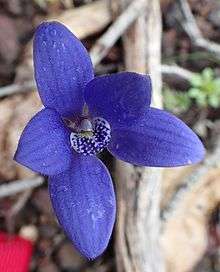Caladenia gemmata
| Blue china orchid | |
|---|---|
 | |
| Caladenia gemmata growing in a Perth suburb | |
| Scientific classification | |
| Kingdom: | Plantae |
| Clade: | Angiosperms |
| Clade: | Monocots |
| Order: | Asparagales |
| Family: | Orchidaceae |
| Subfamily: | Orchidoideae |
| Tribe: | Diurideae |
| Genus: | Caladenia |
| Species: | C. gemmata |
| Binomial name | |
| Caladenia gemmata | |
| Synonyms[1] | |
Caladenia gemmata, commonly known as the blue china orchid, is a plant in the orchid family Orchidaceae and is endemic to the south-west of Western Australia. It has a small, oval leaf and up to three intense blue to mauve flowers. It is the most common and widespread of the West Australian china orchids, sometimes appearing in large numbers after summer fires.
Description
Caladenia gemmata is a terrestrial, perennial, deciduous, herb with an underground tuber. It has a single dark green, shiny leaf, 20–40 mm (0.8–2 in) long, 10–20 mm (0.4–0.8 in) wide and purplish underneath. Up to three intense blue to purplish flowers 20–50 mm (0.8–2 in) long and wide are borne on a stalk 40–150 mm (2–6 in) tall. The dorsal sepal is erect, 20–30 mm (0.8–1 in) long and 5–10 mm (0.2–0.4 in) wide. The lateral sepals and petals have about the same dimensions as the dorsal sepal. The labellum is 5–8 mm (0.2–0.3 in) long, 5–7 mm (0.2–0.3 in) wide, purple and blue and curves downward near its tip. There are many scattered small, bead-like calli covering the labellum. Flowering occurs from August to early November.[2][3][4][5]
Taxonomy and naming
Caladenia gemmata was first formally described in 1840 by John Lindley and the description was published in A Sketch of the Vegetation of the Swan River Colony.[6] In 2000, Stephen Hopper and Andrew Brown changed the name to Cyanicula gemmata,[1] but in 2015, as a result of studies of molecular phylogenetics Mark Clements changed the name back to Caladenia fragrans.[7] The specific epithet (gemmata) is a Latin word meaning "with buds, eyes or jewels"[8] referring to the labellum calli.[3]
Distribution and habitat
The blue china orchid is a common and widespread china orchid found between Kalbarri in the north and Israelite Bay in the east, growing in a range of habitats from heath to forest. Plants growing in wetter areas tend to flower more profusely after summer fires.[2][3][4][9]
Conservation
Caladenia gemmata is classified as "not threatened" by the Western Australian Government Department of Parks and Wildlife.[9]
References
- 1 2 3 "Cyanicula gemmata". APNI. Retrieved 12 April 2017.
- 1 2 Jones, David L. (2006). A complete guide to native orchids of Australia including the island territories. Frenchs Forest, N.S.W.: New Holland. pp. 29–30. ISBN 1877069124.
- 1 2 3 Brown, Andrew; Dundas, Pat; Dixon, Kingsley; Hopper, Stephen (2008). Orchids of Western Australia. Crawley, Western Australia: University of Western Australia Press. p. 189. ISBN 9780980296457.
- 1 2 Hoffman, Noel; Brown, Andrew (2011). Orchids of South-West Australia (3rd ed.). Gooseberry Hill: Noel Hoffman. p. 194. ISBN 9780646562322.
- ↑ Archer, William. "Blue China Orchid - Cyanicula gemmata". Esperance Wildflowers. Retrieved 12 April 2017.
- ↑ "Caladenia gemmata". APNI. Retrieved 12 April 2017.
- ↑ Clements, Mark A.; Howard, Christopher G.; Miller, Joseph T. (13 April 2015). "Caladenia revisited: Results of molecular phylogenetic analyses of Caladeniinae plastid and nuclear loci". American Journal of Botany. 102 (4): 581–597. doi:10.3732/ajb.1500021. PMID 25878091.
- ↑ Brown, Roland Wilbur (1956). The Composition of Scientific Words. Washington, D.C.: Smithsonian Institution Press. p. 170.
- 1 2 "Cyanicula gemmata". FloraBase. Western Australian Government Department of Parks and Wildlife.